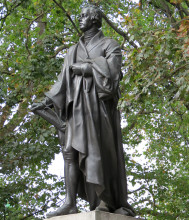 Statue of Pitt, by Francis Chantrey.
Statue of Pitt, by Francis Chantrey.
 Statue of Pitt, by Francis Chantrey.
Statue of Pitt, by Francis Chantrey.
There are two squares off Oxford Street just to the west of Oxford Circus – to the north of John Lewis is Cavendish Square, and to the south, down Harewood Place, is the slightly smaller Hanover Square; it is also close to Regent Street, being connected by the two short roads of Princes Street and Hanover Street. Just south of the Square is the Classical church of St George, also noted here.
‘A colossal statue of bronze was erected in Hanover-square, at the end of last year, to the memory of William Pitt. The orator is represented in the act of speaking. This statue, which in many respects is the finest in London, is the work of Mr Chantrey.’
That was written in 1832, soon after the statue was put up, and the statue is indeed fine, showing Pitt standing tall, enveloped in a great robe with wide sleeves, to give him a classical patrician look. The drapery is carefully worked out, and worth study. The combination of this classical robe with contemporary clothing to legs and neck - almost the only parts visible - somehow looks effortlessly natural. Pitt has one hand on his chest, the other holding a scroll.
We may mention that a very modern sculpture has been placed within the Square, with a bird on top of some great leafy plant, perhaps a sunflower.
Spiky domes at corner with Harewood Place, and lionskin window-top to 13 Hanover Square.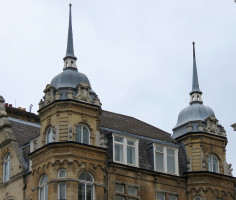
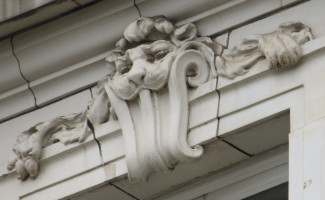
Hanover Square was the first Mayfair square, laid out between 1716 and 1720, and a few houses survive from that time, both in the Square itself, and along St George Street to the south. However, most of the older buildings surrounding the Square have been lost, including a late 19th Century one with decorative figure sculpture by the architect John Belcher. An important survivor is the several-domed building running the full length of Harewood Place, with short frontages to Oxford Street (no. 293) and Hanover Square. On the opposite corner, no. 13 Hanover Square is crisply white, with minor decoration including odd lion-skin tops to the upper windows. No 7, just one bay wide, is by the architects Treadwell and Martin, and on the frontage includes a cartouche and two rather elegant many-winged cherubic heads. It dates from 1908.
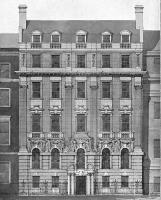 Lost decorated building in Hanover Square by John Belcher.
Lost decorated building in Hanover Square by John Belcher.
From the south side of the Square, standing by the Pitt statue, we can see the Classical frontage of the church of St George Hanover Square. This is one of the dozen churches built under the 1711 Act intended, over ambitiously, to build some 50 churches in the ever-growing London suburbs. The timing of Hanover Square being laid out, just six years later, was perfect, and the local populace duly received one of the new churches. St George Hanover Square is the work of the architect John James, who was one of the surveyors appointed under the Act. A very Classical church indeed, with an extremely fine portico, six Corinthian columns wide, with a pediment on top enclosing a porthole window. The solid, square tower rises straight from the centre of the building, with no obvious support – an innovation in those times, when Wren had built all of his churches with their towers rooted firmly and visibly to the ground. No monuments within to speak of, but we should at least note the stained glass, some of which is 16th Century, and derived from a French convent.
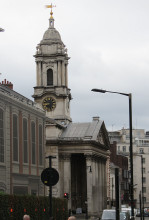 Oblique view of St George Hanover Square, by John James.
Oblique view of St George Hanover Square, by John James.
Finally, a little further along St George Street, on the right hand side, is the Sotheby’s building, no.7 George Street, with two good bronze seated figures above the arched doorway. The one is a girl, with archetypical art nouveau hair, and wearing medieval costume, and reading a large book. The other, male, is an explorer, emblematic of Discovery, contemplating the globe, books at his feet, feather in his hair. These figures are the work of Fritz Roselieb, and date from 1905.
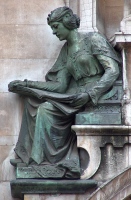
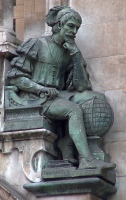 Fritz Roselieb's sculpture for Sotheby's, St George Street.
Fritz Roselieb's sculpture for Sotheby's, St George Street.
Oxford Street west of Oxford Circus // Go north to Cavendish Square // East to Regent Street
London sculpture // Sculpture pages
Visits to this page from 13 July 2013: 7,654